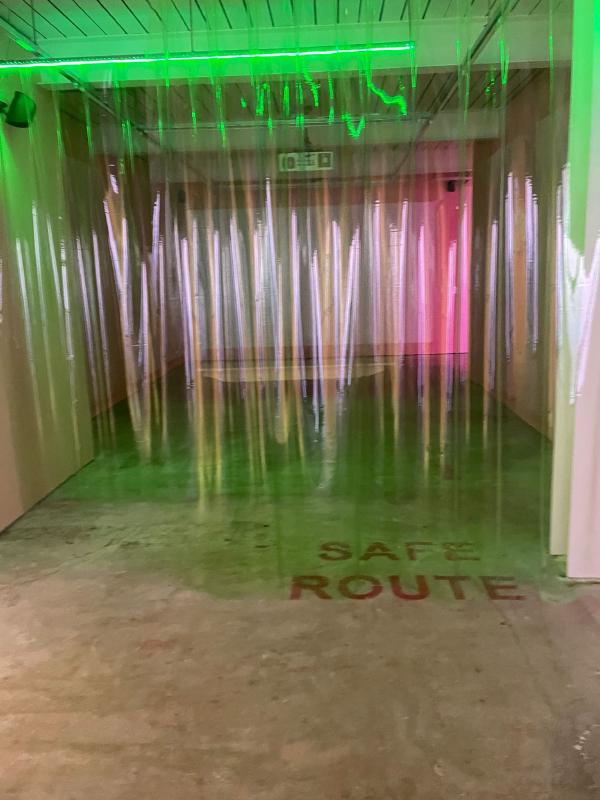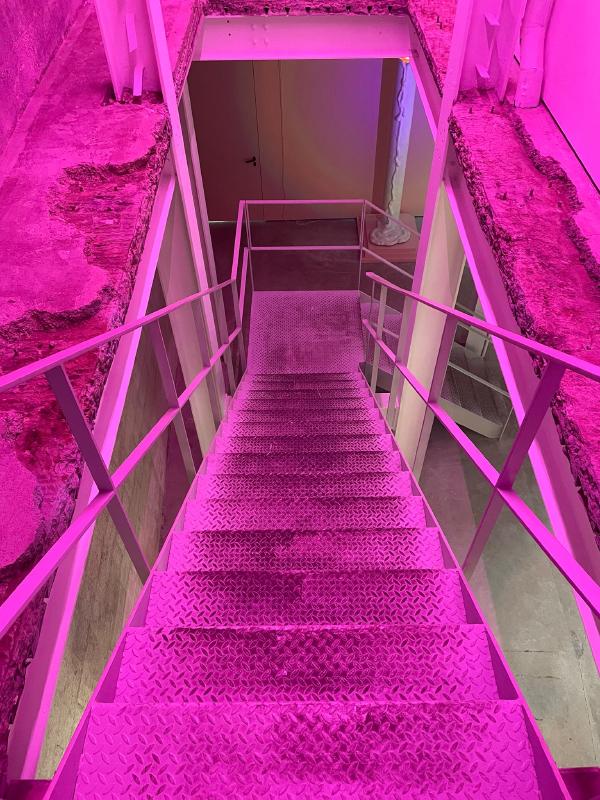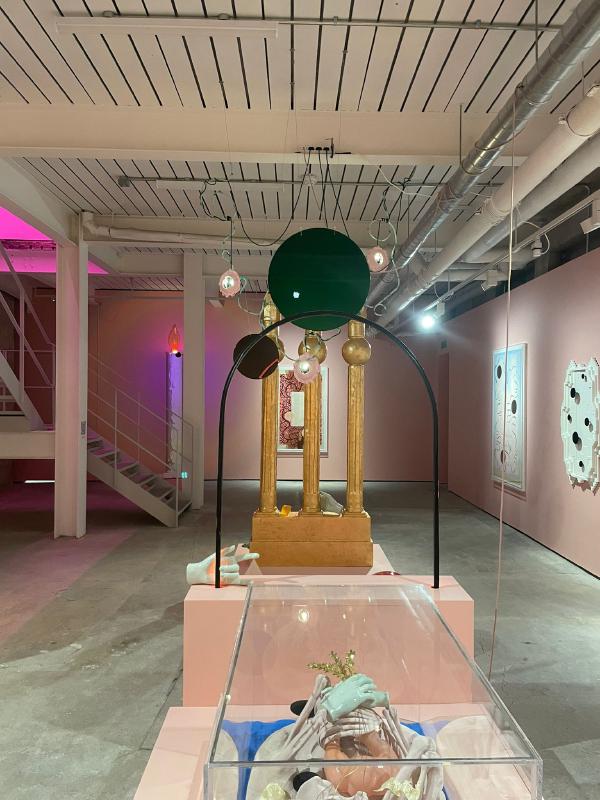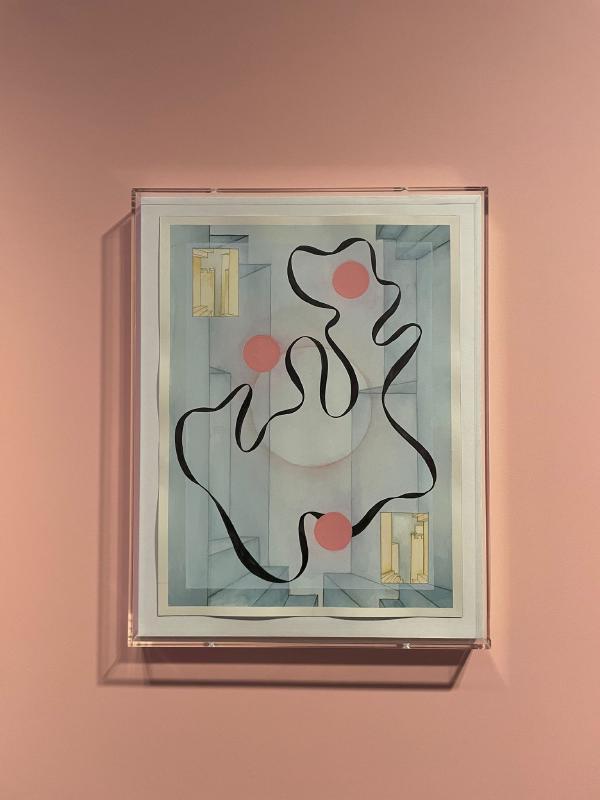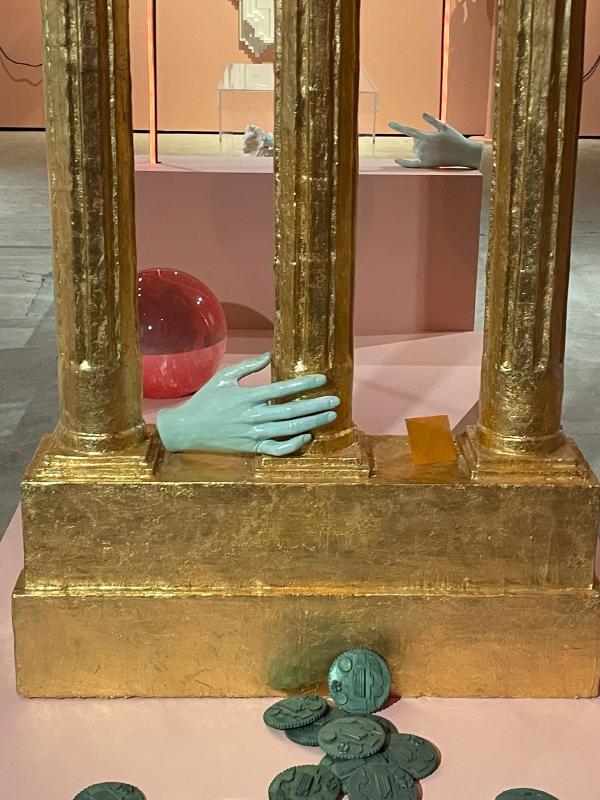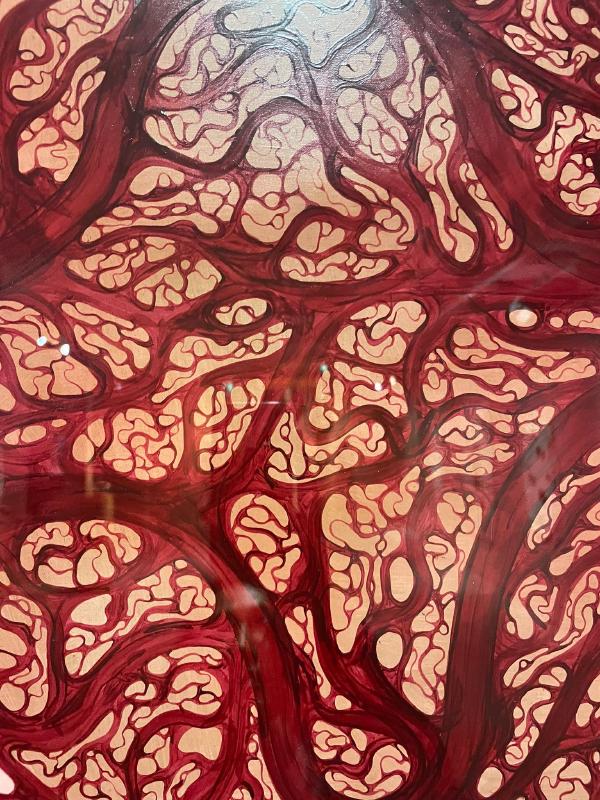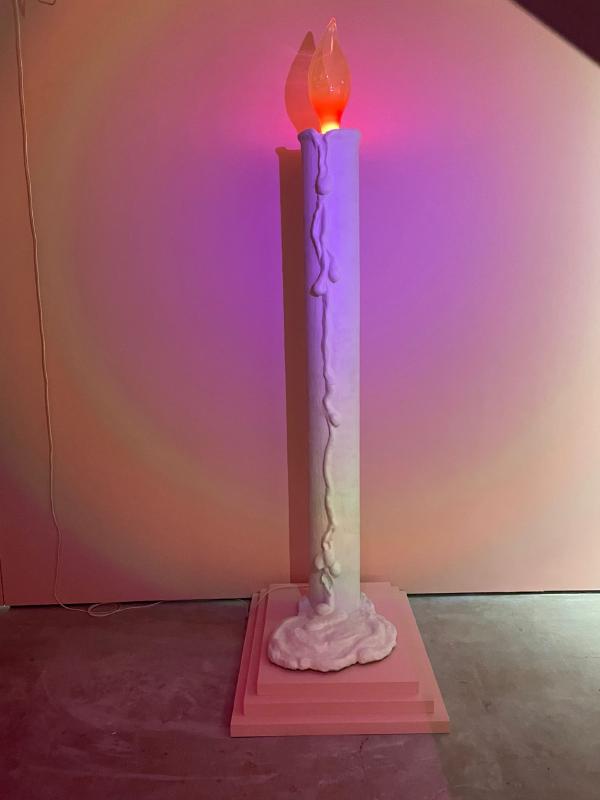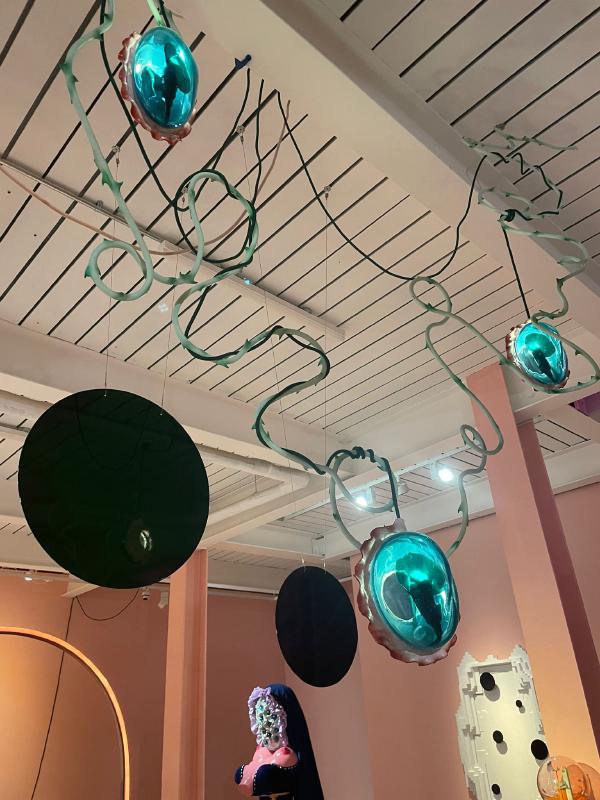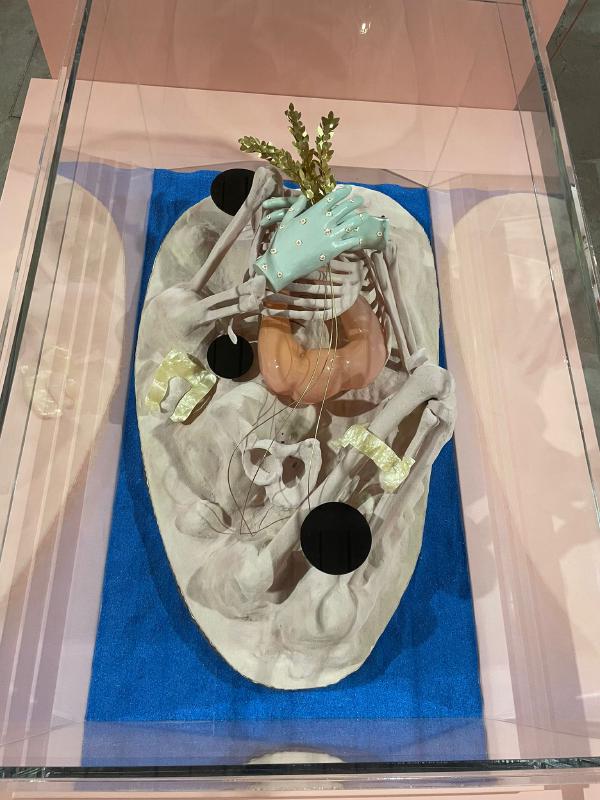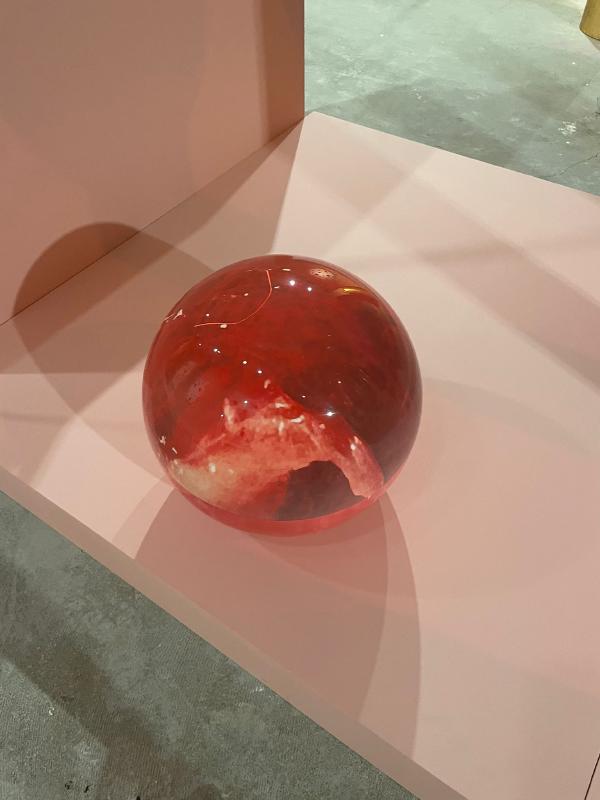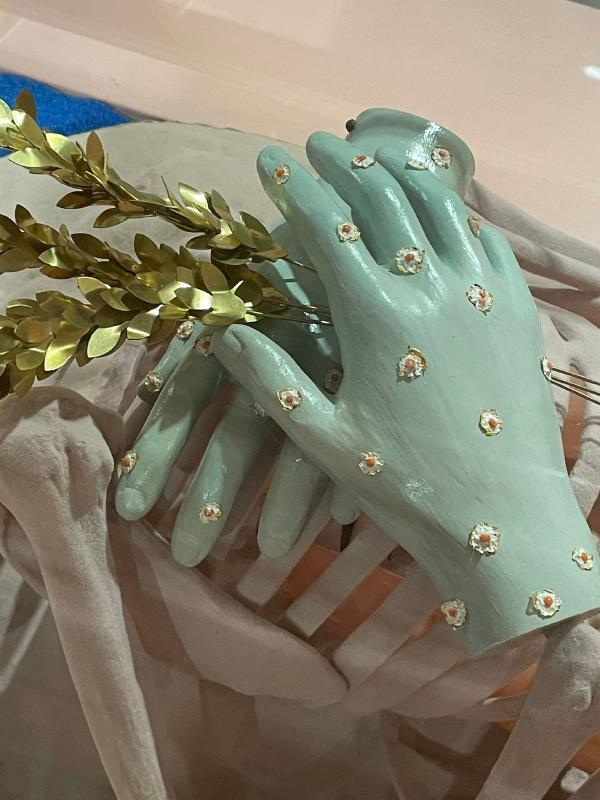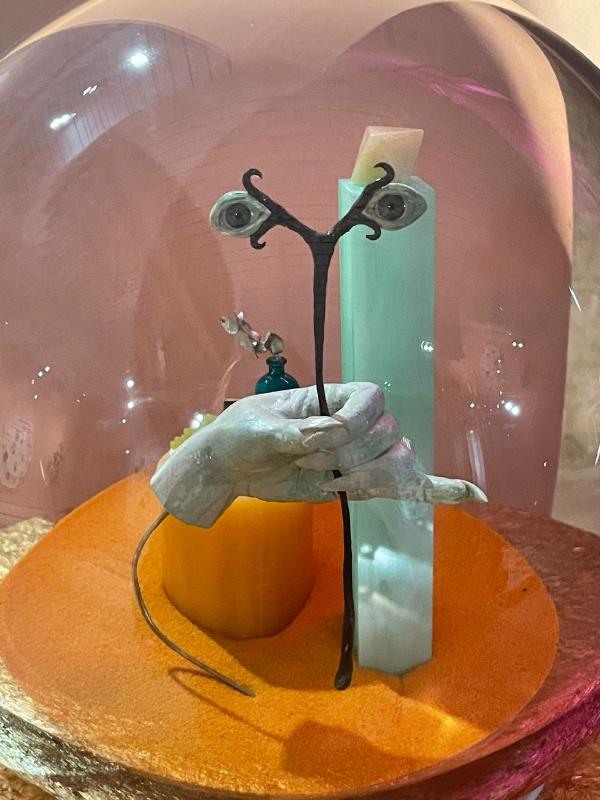Tai Shani @ Gathering
ZM
Emoji summary: 😇🍞💀
I am obsessed with the lives of saints. I cannot stop clicking along the link chain, swinging from wikipedia page to wikipedia page. I want to know everything about these ancient people and their primordial landscape: Jerome and Anthony and Ælfric of Eynsham. It started when I read the Doloriad and got swept up in the rush - the cartoon figure of St Thomas Aquinas as a daytime TV talkshow host, interloper, haunted by those silent sheep, the cameras and lights. Yes, yes, I am obsessed with all of it: loaded arcane symbolism, the medieval, the body horror of a gruesome death, meeting gruesome death with noble stoicism. The wandering saint, penitent in the wilderness. I turn to the camera, my eyes full of sparkling mischief because everyone knows I am ready to say the line: SOMEONE GET AQUINAS IN HERE!!!!!!!
The gallery looks like it used to be a car park. There are steps up at the door. The concrete floor is rough and cracked. SAFE ROUTE in red stencilled caps, spray painted on the floor. The walls are baby pink and the lighting is green overhead. I feel like I am in an enormous mouth, about to begin my journey through to the gentle wet darkness of the small intestine —- to see Tai Shani’s exhibition at Gathering.
A saint who lived by the Red Sea. St Anthony, the father of monks. He left the comfort of his riches to live a life of penitence and solitude. Wandering in the desert, he was tormented by demons and terrible visions sent by the devil. His most spectacular miracles were his healings. He specialised in healing ergotism; the convulsive symptoms of ergot poisoning. Ergot is a black fungus that grows on rye. Infected grain heads look noticeably different, with protruding black pegs of fungus jutting out at odd angles. When eaten, ergot causes fevers, hallucinations and distorted perception.
They called it St Anthony’s fire: an epidemic of ergotism spread through Tsar Peter the Great’s army as they marched down the Terek steppe. Men who ate the poisoned bread either died from the nerve contractions or watched as their hands and feet fell off. And again in 1951 in the town of Pont-Saint-Esprit in Southern France where victims saw flames, hellish creatures, infernos. Some wandered the streets screaming, or flung themselves from windows in terror. It was traced back to the cursed bread of one bakery.
There’s a small island just off the coast of Sicily, in the Aeolian archipelago. It’s called Alicudi. There’s only one restaurant. The main mode of local transport is donkey. It’s so remote. It’s a tough place to live. In the 1900s, harvests started failing. People in Alicudi started having visions: women growing wings and flying to the mainland to steal food, ghosts shitting in the bushes, men turning into donkeys. A legend spread. These women were witches and at night they would stare in the mirror, cover their bodies in a special ointment and fly together in hordes across the sea. They would go to the mainland, to Palermo or Calabria, and return with bags full of food and treats and shopping. The island was starving, so of course that’s what witches would dream of doing with their powers. Harvests were scarce and food was precious. They couldn’t afford to throw away the rotting grain heads, even though they had little black pegs of fungus jutting out of them —
Bread and social unrest — there’s something that I would like to read about. The history of bread, as it relates to periods of social unrest. Apparently the price of bread is the best single indicator for predicting political instability. Hungry people are liable to dream of stealing or looting because hunger is a kind of political agent. I am in the small intestine, in the gallery, thinking about how hungry people are liable to burn down buildings.
Historians say that by the time the French Revolution came around, rural unrest was already in the air. There was a grain shortage in the spring and French peasants were gripped by conspiracy theories about an aristocratic plot to purposefully withhold food in an attempt to starve them out. Scared and hungry, they armed themselves and stormed noble estates. They were searching for letters of feudal privilege, documents that granted the feudal lords their privileges over the peasantry. Once found, they burned the documents and left. That was all they really wanted. There were only three confirmed cases of a landlord being killed in the uprisings. Most feudal aristocrats fled of their own accord. Historians have got a theory about the panic in the air though. Something about how when the harvest was poor and food was scarce, peasants couldn’t afford to be so picky about the rye they milled, or whether it was contaminated with —
But there is something in the air, something that traverses the electric space between us as we mill about, on the streets, in our cities. At sunset, when we crash about with nowhere to go or be seen because we are alive in this economy. Because Russia invaded Ukraine, the breadbasket of Europe, or post-pandemic bounce back, or crash, or because the government or all governments. Yes, yes, something in the air. The saints turn, Jerome and Sebastian and Anthony. Ancient people, primordial landscape. They ask the undead, what makes them undead? And the undead (that’s us! that’s our cue!) turn back to them and reply. We speak as one, in chorus: Necropolitics is the use of social and political power to dictate how some people may live and how some must die.
Saints & bread, saints & bread. Wait — I’ve forgotten the undead. Them too. Saints & bread & the undead or the nearly dead or the socially, politically dead.
Art-making can be an attempt to close the gap. Art doesn’t just have to be about things. You can make towards a theory or a history or a politic — aesthetic, object, palpable mood. In offering, as gesture or an attempt to close the gap between interest and understanding.
I think Tai Shani’s work makes an aesthetic gesture. It moves towards things, rather than being about things. Your Arms Outstretched Above Your Head, Coding With The Angels at Gathering. The pink walls in the entry are lined with A4 prints: little spacey ribbons dance and twirl, disembodied across empty, resonant spaces. The resonance is implied or projected. I am telling you, take my word, something is echoing across these fields of open colour. Little windows fold architecture together and apart: stairways and arches, cloister, colonnade, vault, crypt. The images are punctured by dense circles, opaque and heavy with their own pigment. Thick pink, baby blue, ochre and orange, but most importantly: black. Rot and spore, lurid colour.
My body is drawn to the hot pink neon glow of the stairs. I tumble down them into a basement (a crypt). It would be a crypt in the same way our stomachs are crypts; dark, the gentle wet pink of interior lining, coated in bile and webbed capillaries. Votive, offering: a giant candlestick towers above us. Cartoon drip melts in a steady stream down the length, into a pool at its base. Static and solid. It’s a prop. It’s camp, or kitsch — I can’t tell the difference anymore, can’t decide. It’s in the space and its giant-ness makes itself known, my body reacts. A relic in a glass orb: a tiny disembodied mint green hand holds two disembodied eyes on a stalk. Saint Lucia, virgin martyr. She gouged out her own eyes, or her eyes were gouged out — on the orders of the emperor or a spurned suitor or — well. She carried Dante to the gates of purgatory as he slept.
Then, a centrepiece: a gold colonnade, green coins the size of a fist, a disembodied mint green hand, a pink glass orb, amber prism. This is a collection that has fallen out of the reliquary. Flat black circles hang, suspended in the air above. They are horrifyingly solid, thrown into stark matte relief against glowing turquoise glass and green vines. The reliquary is behind, in a glass case: cast of bones (ribcage, femur, skeleton arm) with a mint green hand, holding a gold laurel leaf, containing pink glass, pearl shard, bedazzled by little fried egg studs. A relic of a saint: the sacred body, defiled by the gruesome horror of its death, or made more holy by the quality of suffering. Because through sufferance we understand the suffering of Christ, Man of Sorrows. The reliquary is punctured by flat black circles. It would be a crypt in the same way crypts are dark containers for a body unbound by horror, by sorrow, by suffering—
The paintings are bigger down in the crypt. The same ribbons dancing across resonant space and folded architecture. They are the size of altarpieces and here, the dense circles are all black. Voids, spore. The black circles puncture the paintings and leak across the space, through the crypt.
The saints are singing, they are singing about how necropolitical forces are banal, ubiquitous and embedded in our post-post-modern times. Because it is about the right to expose people to death, or a lack of life (however you define a life) or living. A theory of the walking dead, in which specific bodies are forced to remain in suspended states, somewhere between life and actual real death. It is a theory, sure. But we see it moving everywhere in front of us. It is politics, society, the state or the social contract, it’s the economy stupid! It’s a ghost that moves through the air between us, electric. (It creates what Achille Mbembe calls deathworlds, new and unique forms of social existence in which vast populations are subjected to living in conditions that confer upon them the status of the living dead.) The singing saints, full of sorrow. Their bodies are sacred, but they are not their own. And that is a kind of suspended state: when you are no longer sovereign over your own body. When you are unbound, cut loose, at the whims of a force that’s bigger than you. The state, the invisible hand of the free market, the will of God.
Shani’s show is not about dreams or magic. It’s not even really religious or spiritual. I think it is a kind of hallucination, in that it is entirely real and entirely internal. It moves towards the meeting point: body and horror and the politic that’s built when those two things touch. It is about the way pain, sorrow, suffering opens up a doorway within ourselves. Pain, sorrow, suffering, abjection is active — it is an agent or force that pushes through itself into a new space. It is the precursor to a specific kind of desire. There are visual cultures that have understood that intimately; saved the sacred bodies that experienced such holy suffering. There are cultures that have understood the desire to open up a door within yourself and fly out across the sea in hoardes to the mainland, burn letters of feudal privilege. There are cultures that have understood the tender thread that links bread and bodies and desire and death, how bread is a kind of body, a social body or a sacred body (the body of christ, but that’s too far, that’s overkill, isn’t it?)
Maybe the crypt is one of many imageworlds, a space where the relationship between darkness and images has to emerge, recalibrated and different. Maybe undeath or nearly death or social, political death is a suspended state in the same way that hallucinating from contaminated bread is a suspended state, and both of these states are active political agents that open a doorway into a new space where the saints are singing *about the banality of necropolitics in our post-post- modern times, we are on the brink of civil unrest because Russia invaded Ukraine, the breadbasket of Europe, post-pandemic bounce back, crash, the government, all governments, government on high. On the streets, in our cities, at sunset. Desire is such a powerful force. It is real. It is a body of its own. It joins the crowd as it heaves towards fantasy or forever. I would like to believe them — Anthony, Lucia, Jerome, Catherine, Sebastian. Their song is a whisper now, barely audible. I think they said that maybe we are meant to perish. Maybe through death, we exit into new space, a new imageworld. I think they said something, how there’s something in the air, electric between us.
